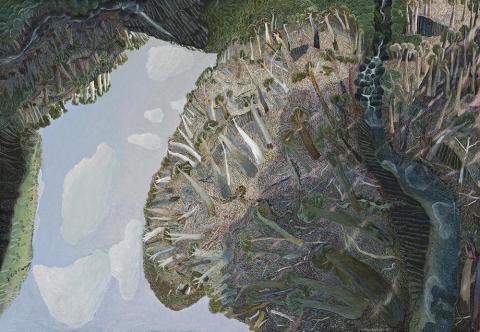LANDSCAPE WITH TWO WATERFALLS, 1990
WILLIAM ROBINSON
oil on canvas
138.0 x 198.0 cm
signed and dated lower right: William Robinson 1990
inscribed with title verso: LANDSCAPE WITH TWO WATERFALLS
Ray Hughes Gallery, Sydney
Private collection, Sydney
William Robinson: Paintings, Ray Hughes Gallery, Sydney, 28 September – 20 October 1991
The 1990s was an important decade for William Robinson. At the age of 54 he had recently retired from teaching and had begun painting full-time. He won the prestigious Wynne Prize for landscape painting in 1990, again in 1996, and his second Archibald Prize win came in 1995. His 1991 solo exhibition, featuring works based on the Beechmont Range near Canungra in the Gold Coast hinterland, William Robinson: Paintings, was met with critical acclaim and sold out prior to the exhibition opening. Landscape with Two Waterfalls, 1990 was amongst these keenly sought after paintings.
This exhibition heralded further major developments in Robinson’s painting. The whimsical elements which were so important to many of his works until now, gave way to a more mature, spiritual perspective on the landscape. His pictures began to take on a grander scale as his view of the landscape zoomed back allowing the hills and horizons to form folding vistas. Robinson often refers to the concepts of creation when discussing or titling his paintings. In the Beechmont paintings it is the creeks and rivulets that represent the touch of the creator, these being the timeless architects of the hills and gorges which form the Beechmont Range. The waterfall which cascades to the right of the composition has a soft gravitational pull which draws the viewer’s eye and causes one to read the picture in a clockwise direction.
In 2001, for the first major monograph on his work, Robinson reflected on his approach to the Beechmont paintings... ‘My walks were very important for setting out the paintings. They were the direct result of walking, and have some feeling of wandering around in them. Through all this they more and more included the sensation of being in the landscape. These paintings are inner visions of mine; visions that are searched out after being given a jump start by thoughts on the landscape and nature. I strive to give meaning to those basic feelings and questions that we all have. Why do we have such powerful responses to nature and why do its visions and moods affect us so deeply. I feel that we are given moments of insight into things that are not seen as facts but as interior experiences. These visions are not fully formed pictures, but I strive to hold them and form them once they begin.’1
Robinson would occasionally pre-empt changes in his works as he neared the end of a series. For example, he may choose to finish with images of sunsets, thus gently closing one door as another opens. A further delicate pointer in Landscape with Two Waterfalls is the row of cows in the lower left of the painting. These cows and other farm animals played an important role in formulating Robinson’s rigorous compositional innovations. Therefore, in a mischievous aside, Robinson acknowledges the important role these animals played in his works, as he depicts them exiting the picture lower left in an orderly procession.
1.Robinson, W., quoted in Klepac, L., William Robinson: Paintings 1987 – 2000, The Beagle Press, Sydney, 2001, p. 89
HENRY MULHOLLAND
